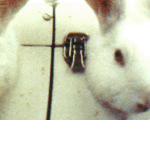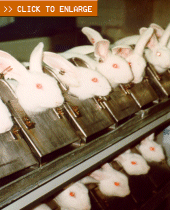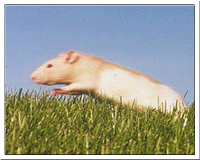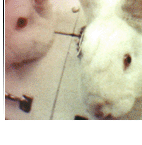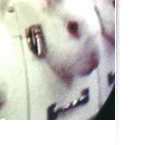When we buy a box of laundry detergent or a tube of toothpaste, we trust that the ingredients are considered safe for human use. We also trust that in the unfortunate event of the product’s misuse, for example a young child feasting on fruit-flavored toothpaste, a detailed and knowledgeable plan has already been established to remedy the situation. The companies manufacturing our household and personal care products are indeed aiming to ensure our safety, either out of a fear of financial liability or due to a sense of moral responsibility. So household and personal care products, and their ingredients, are tested to determine general toxicity, skin and eye irritancy, ingestion and inhalation effects, and allergic reactions.
Federal law requires that personal care and household products be proven safe for human use. This can be accomplished by safety testing or by using GRAS (Generally Regarded As Safe) ingredients. Federal law does not require the use of animals in the safety testing of household and personal care products; manufacturing companies choose which tests to use. Sadly, many companies choose animal tests to determine the human suitability of their products. Yet using animals to seek information about humans is cruel, misleading, and ineffectual.
In the Lethal Dose:50 test (LD:50), mice, hamsters and other animals are force fed household products or personal care items. A feeding syringe is forced down the animals’ throats, injecting a chemical ingredient of the product, or the product itself, into their stomachs. These animals endure ulcerations, vomiting, bleeding, convulsions, and death. This forced feeding increases in amount until half of them die. Notes are made as to the quantity needed to kill 50% of the animals, then the survivors are killed. No harmful effects are noted or measured, only the animals’ lethal dose. Scientists mistakenly perceive these results as determinant of how much of the product a human can safely ingest.
Click here to learn about other tests.
LIFE IN A CAGE
Even when not being poisoned or mutilated in actual experiments, the lives of animals in laboratories are nightmarish. They spend the entirety of their lives in small, barren metal cages. The isolation and boredom alone often cause social animals to become psychotic.
Animals in laboratories are viewed merely as objects. Their ability to suffer and feel is denied or disregarded. As mere “test subjects” they are handled roughly, with no thought to their distress, fear or pain. When not being experimented on, these animals still enjoy no comfort at all, sleeping on cement or metal flooring.
Those who do survive the experiments are then "sacrificed"... callously killed and tossed aside.
WHO IS EXPERIMENTED ON?
Many species of animals fall victim to such a miserable life in a product testing laboratory: rabbits, guinea pigs, rats and mice in particular. Rabbits are routinely used because they are docile and thus easy to manipulate.1 Mice are exploited even more often since they are inexpensive and easy to handle. The federal Animal Welfare Act (AWA) is meant to secure the basic rights of animals in laboratories, such as access to food and water. But many animals, such as reptiles, birds, rats and mice are intentionally excluded.2 These animals are given absolutely no legal protection from neglect and abuse.
To learn more about animals in product testing laboratories, click here.
When people hear about product testing on animals, they often assume it is rarely performed, or done only for a specific sort of product, like makeup. The truth is that many of our personal care and household products are still being tested on animals, even though it is not required by law and the results of these tests are unsuccessful in determining human reactions. While many companies have replaced animal experiments with effective non-animal tests, other companies continue to duplicate tests on animals, overlooking the many valid non-animal procedures.
Click here to learn just how many products in your house may have been tested on animals.
WHY ARE ANIMAL TESTS DANGEROUS FOR HUMANS?
Rabbits, dogs, mice and other animals are not human. There are key discrepancies between species--physiologically, anatomically, genetically and histologically--right down to the basic cellular structures.
To learn more about how dangerous these differences can be, click here.
REPLACING ANIMALS WITH VALID TESTS
It is completely natural that we as consumers expect our products to be tested for safety. It stands to reason that "Generally Regarded as Safe" ingredients have stood the test of time. By continuing to use an ingredient that has been safely consumed for decades, companies can be more assured of their product’s safety.
Click here to learn more about available, humane tests.
1. Ron Banks, "Rabbits: Models and Research Applications," United States Army Medical Research Institute of Infectious Diseases (October 1989).
2. Animal Welfare Act, Title 7, Chapter 54, section 2132(g).
.
This website is dedicated to the memory of Matt Fancera.




